This post may contain affiliate links. See my disclosure policy.
Mango Sticky Rice is the most beloved of all Thai desserts. Made with steamed glutinous sweet rice, sweetened coconut cream, and fresh seasonal mango, learn how easy it is to make khao niaow ma muang from home with this easy to follow recipe.
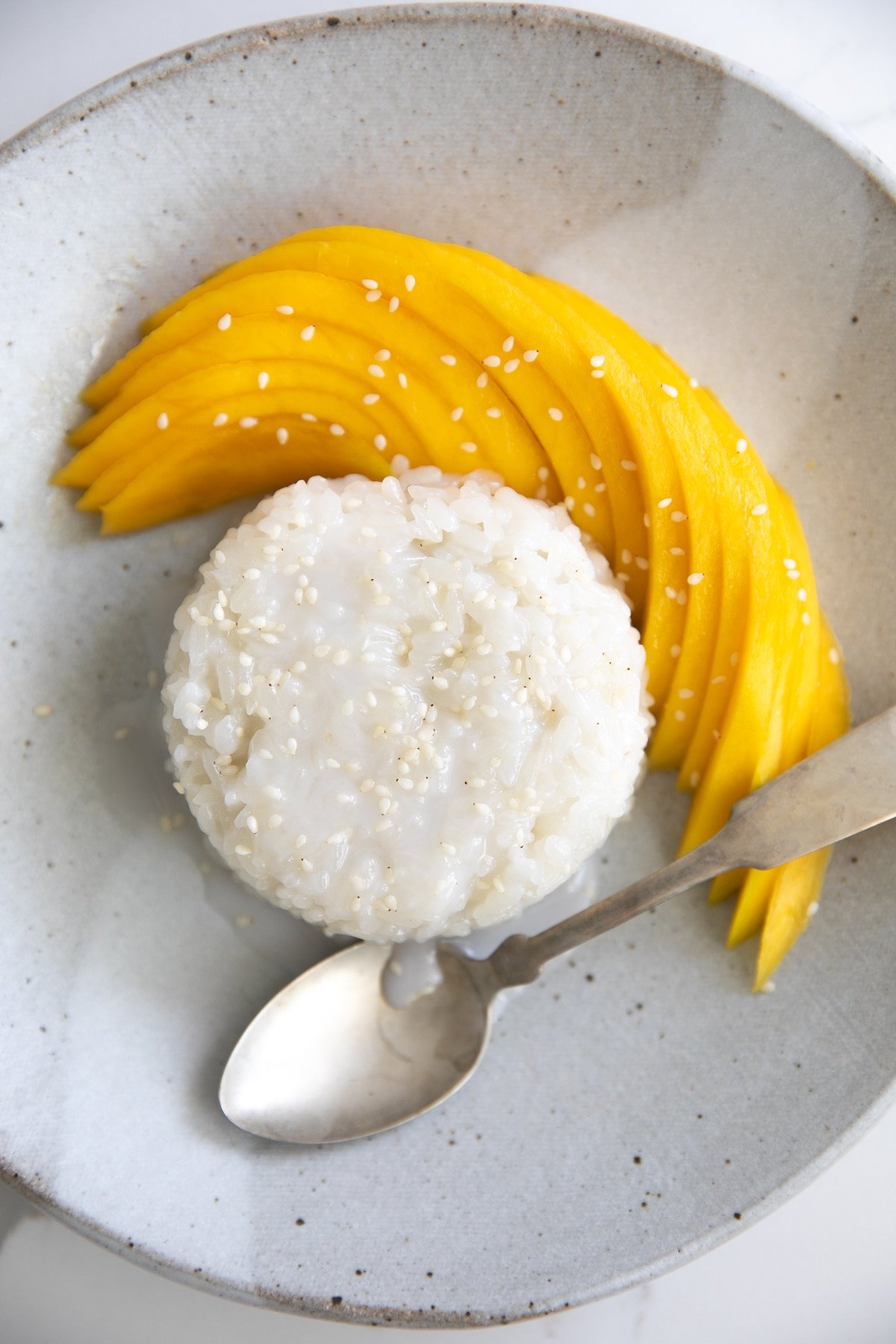
I’m super tempted to tell you all about my first experience with mango sticky rice nearly a decade ago in Thailand…but I won’t. Because I know you didn’t come here to hear about my travels through Thailand or the first time I tried this luscious, creamy treat.
It was a glorious one – this first experience – and one I am so happy to re-live and re-create for friends and family in my very own kitchen whenever I want thanks to this delicious (and super easy) recipe.
If you’re new to this incredible dessert, then let me prepare you because you are about to fall in love.
Some of you may be thinking, what is mango sticky rice?
Mango sticky rice is a traditional Thai dessert made with glutinous rice, coconut milk, sugar (usually palm sugar when made in Thailand), and fresh mango. It is especially popular during the mango season in Thailand and all of Southeast Asia and South Asia which runs from April to May.
RELATED: Thai Iced Tea Recipe; How to Make Thai Tea
Table of Contents
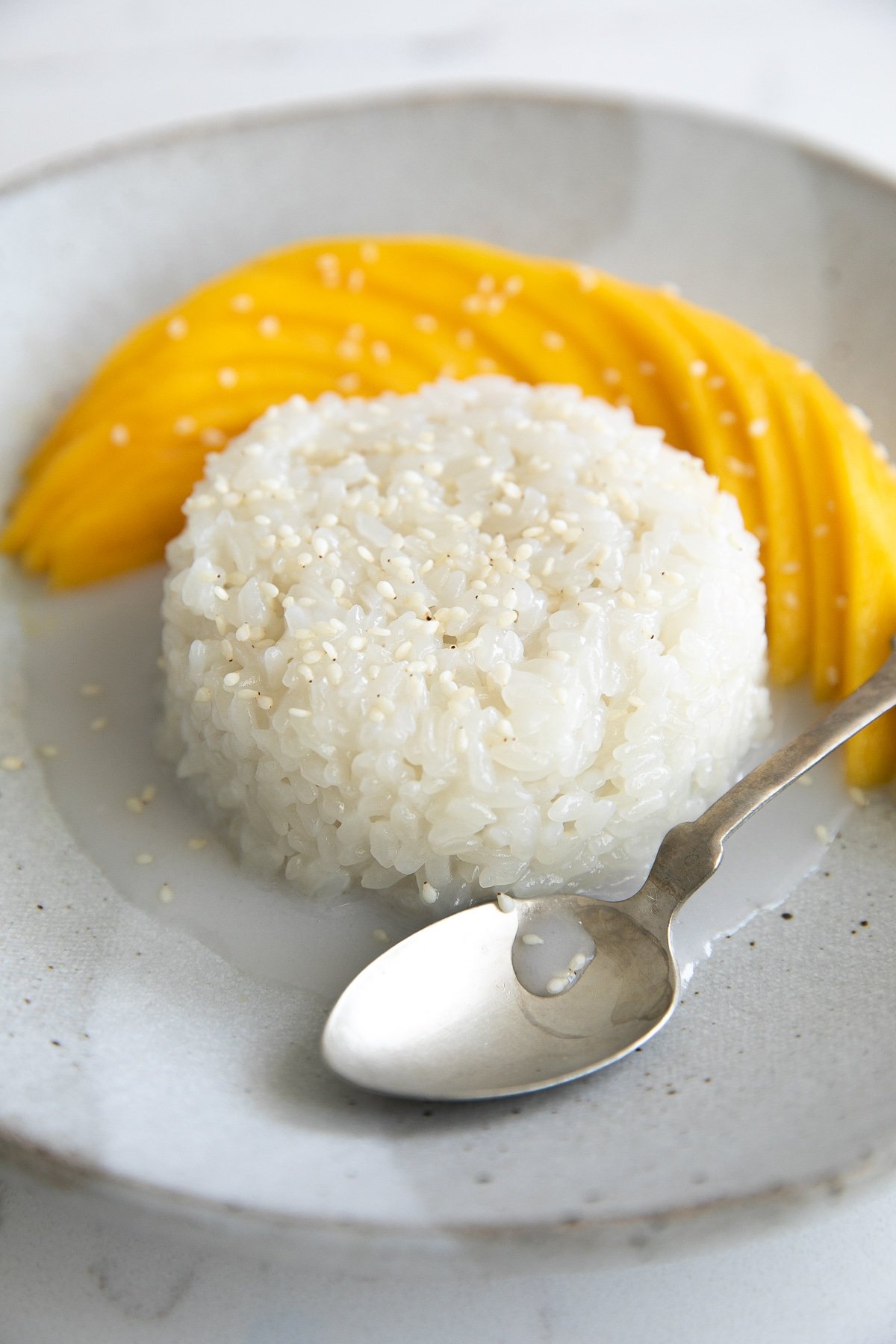
Key Ingredients
- Sweet rice (glutinous rice)
- Coconut milk or cream
- Sugar
- Salt
- Mango
What is sticky rice?
Sticky rice, also known as sweet rice or glutinous rice, is a type of rice grown mainly in Southeast and East Asia, Northeastern India, and Bhutan. Sticky rice has an especially low amylose content resulting in rice that is especially chewy, sticky, and sweet when cooked. All varieties of sticky rice are gluten-free.
However, not all sticky rice is the same. For example, in this recipe, I used Japanese Sticky Rice (also known as mochigome もち米). This type of sweet rice is different from Thai sweet rice ( ข้าวเหนียว). In general, grains of Thai sticky rice is whiter, less opaque, and slightly longer when compared to Japanese rice.
Although it is more authentic to make this recipe using Thai sweet rice, Japanese sweet rice also works and is more readily available from local supermarkets.
So, sweet rice is the same as sticky rice?
Yes
Can I just use regular long-grain white rice?
For true, authentic mango sticky rice, I do not recommend using regular long-grain rice. The grains are more fragrant and aromatic, less sticky and chewy, and the cooking method is different from that of sticky rice.
Can I use low-fat coconut milk?
Yes, but be warned – the taste won’t be nearly as luscious, creamy, or delicious.
RELATED: Coconut Rice Recipe (How to Make Coconut Rice)

How to Make Mango Sticky Rice
First, you’re going to need to gather some tools.
Traditionally, sticky rice is steamed in a woven basket set over a steamer pot. You can buy one on Amazon, but when I tried the expected delivery was more than a month out so I decided to make my own makeshift steamer.
There are several ways to do this. Some people use a rice cooker while others have had great luck using a fine-mesh strainer set over a large pot, but without a tight-fitting lid over the top, I knew I could do better.
Here’s what I came up with instead –
You’ll need a large, tall, deep pot. I used my pasta-boiling pot. To create space between the boiling water and the rice (because we don’t want the rice to be submerged) I inverted (or flipped over) my large mesh stainless steel steaming basket and placed it directly in my pot. The inverted basket creates a “table” to place the cheesecloth wrapped rice on top of and creates a barrier between the boiling water and the rice.
So, you will need-
- A large, tall pot
- A heat-safe steaming basket/stand/or bowl
- Fine-mesh cheesecloth
Now we can get started.
1. Soak the rice for at least 1 hour. Yes, you need to soak your rice. You do not need to soak it overnight (although you can), but you will need to let it soak for 1-2 hours for best results.
2. Drain and rinse the rice and transfer to the center of a large piece of cheesecloth. Allow the rice to drain before loosely wrapping or knotting the top so that all the grains are secure but there is some room for the grains to expand as they steam.

3. Prepare your steamer or use a sticky rice steamer pot (if you have one). Remember we’re steaming the rice (like we would steam vegetables), so we want to keep the rice out of the boiling water.
4. Add enough water to your pot so that it is filled by approximately 1-inch. Add the wrapped-up rice to the inside of the pot and place it one whatever makeshift basket or barrier you’ve come up with. In my case, it was the steaming basket. Cover with a tight-fitting lid and bring water to a boil over high heat. Reduce heat to a simmer and allow the rice to steam for 15-20 minutes, or until grains become translucent.
5. As the rice is steaming, heat the coconut milk in a small saucepot over medium heat. Stir often as we do not want the coconut milk to burn or boil. Add the sugar and salt, stirring continuously until dissolved, then set aside to keep warm.
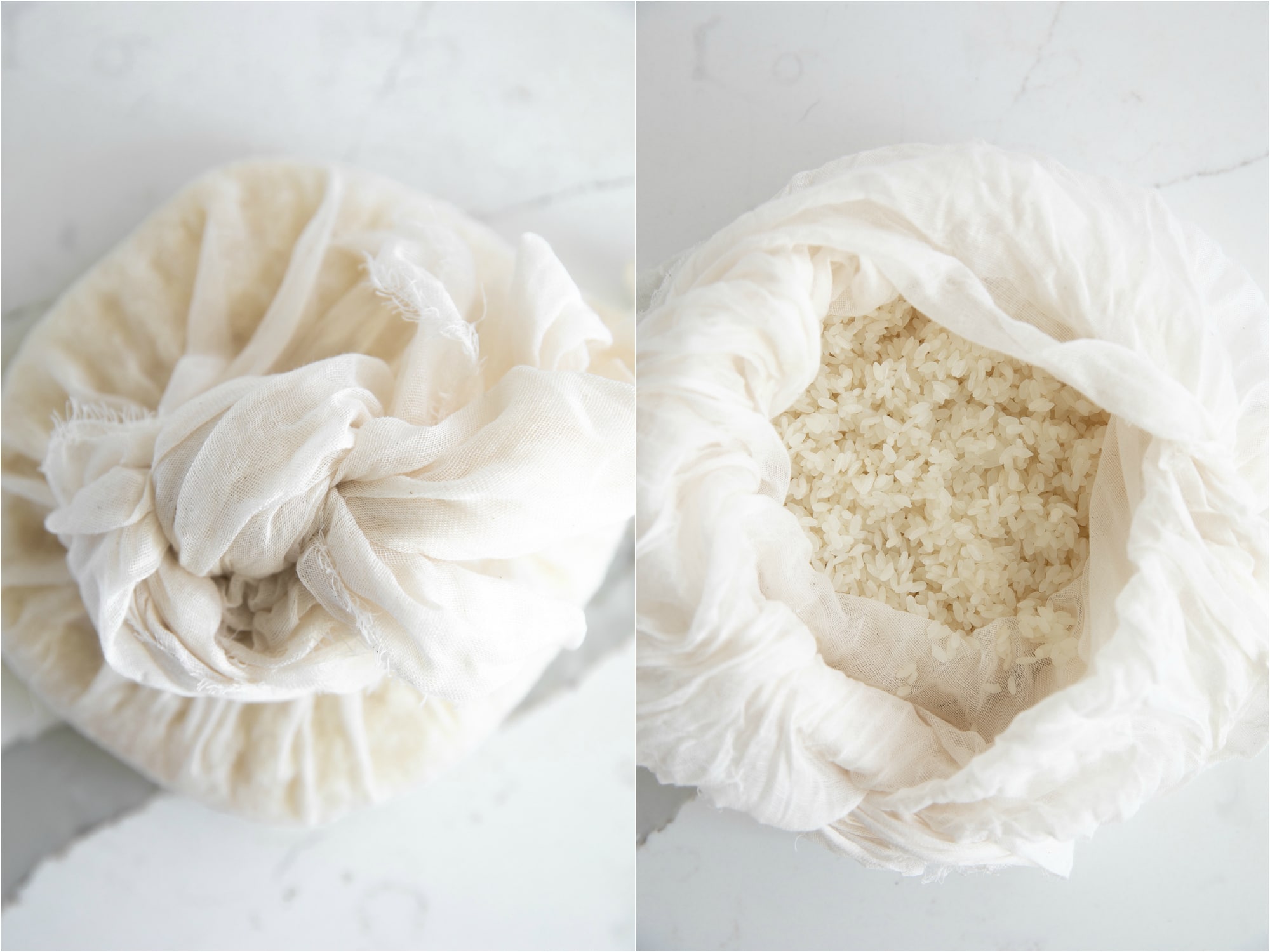
6. Once the rice is finished steaming, transfer to a large bowl and drizzle with the warm, sweetened coconut milk mixture. Cover and allow the rice to absorb the coconut milk for at least 5 minutes.
7. Prepare the coconut cream sauce by gently heating the remaining coconut milk with sugar. Serve warm or make ahead, refrigerate, and serve chilled over your warm cooked rice.
8. Serve a generous scoop of sweet sticky rice with a side of fresh ripe mangoes and a drizzle of sweet coconut cream sauce. Garnish with sesame seeds or mung beans, if desired.
Sticky Rice: Storage and Reheating
Sticky rice has the best texture and flavor still warm and just after cooking. However, leftovers store well in an airtight container and in the refrigerator for up to 5 days.
To reheat, transfer the desired amount of sticky rice to a small microwave-safe serving dish and cover with a damp paper towel. Microwave for 30-60 seconds, or until warmed through.
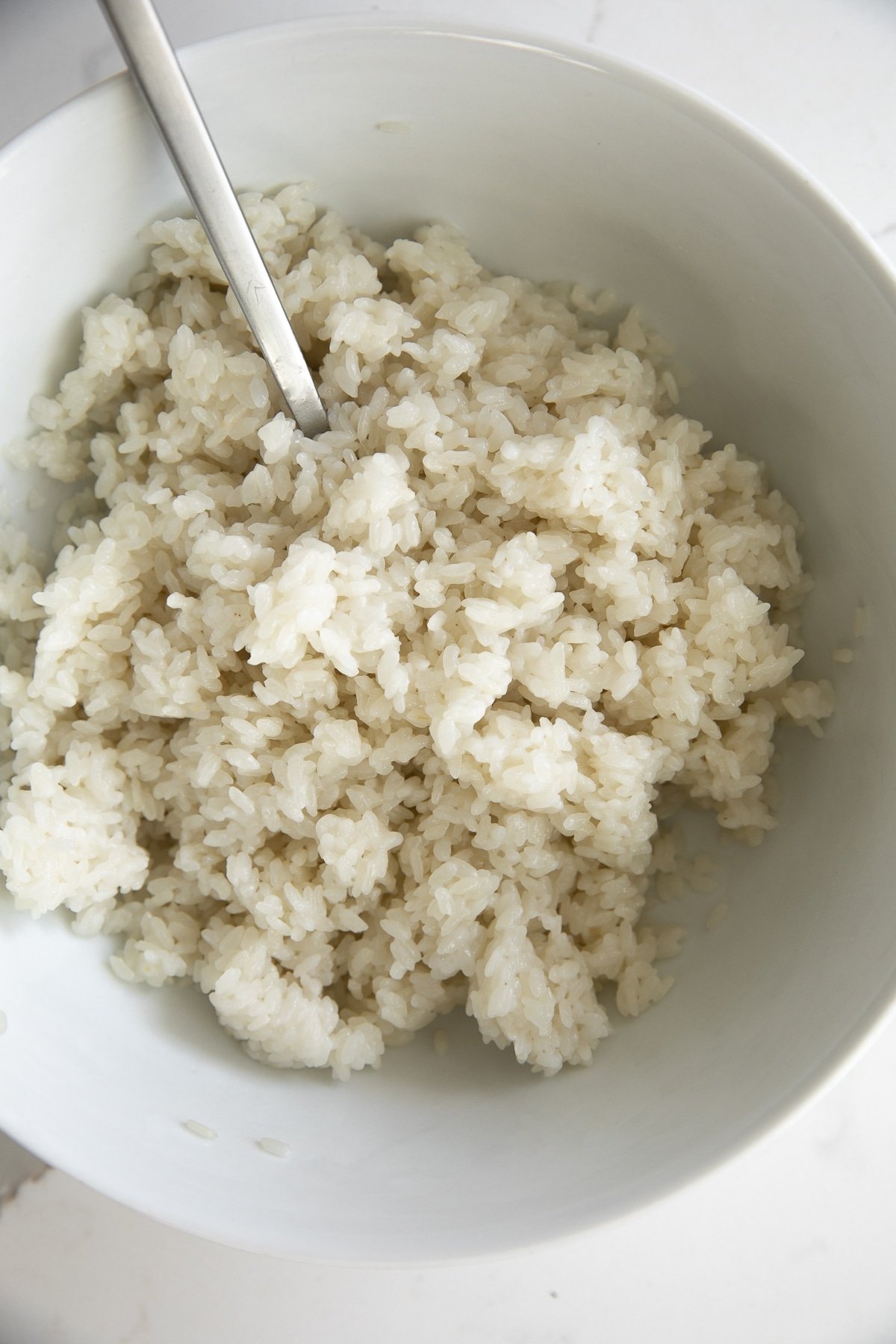
More Thai Food Recipes,
Pad See Ew Recipe (Thai Noodles Cooked with Soy Sauce)
Thai Basil Chicken Recipe (Pad Kra Pao Gai)
Easy Thai Fried Rice Recipe (Khao Phat Kaphrao)
Pineapple Coconut Thai Fish Curry
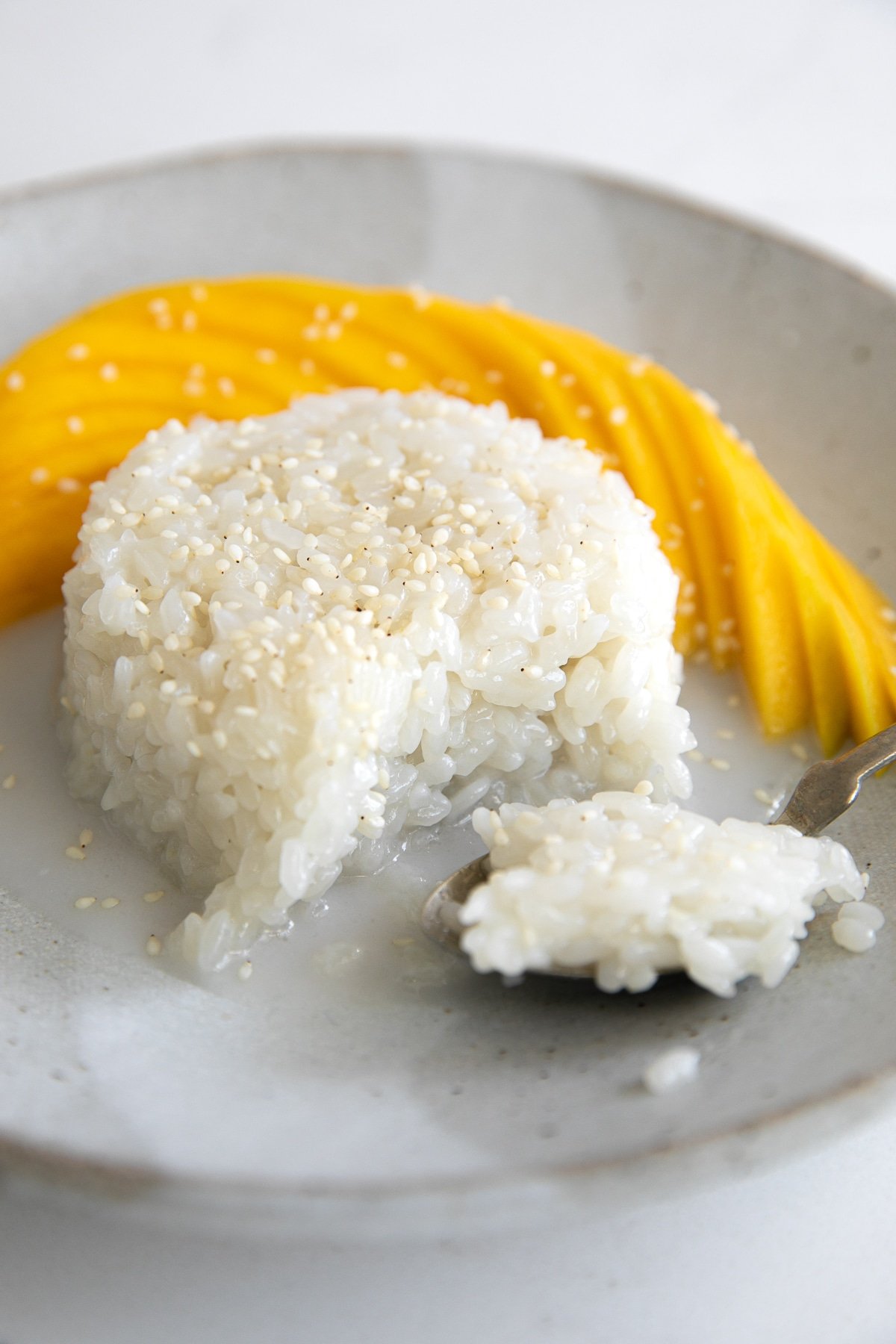
If you try this Mango Sticky Rice Recipe, please leave me a comment and let me know! I always love to hear your thoughts.
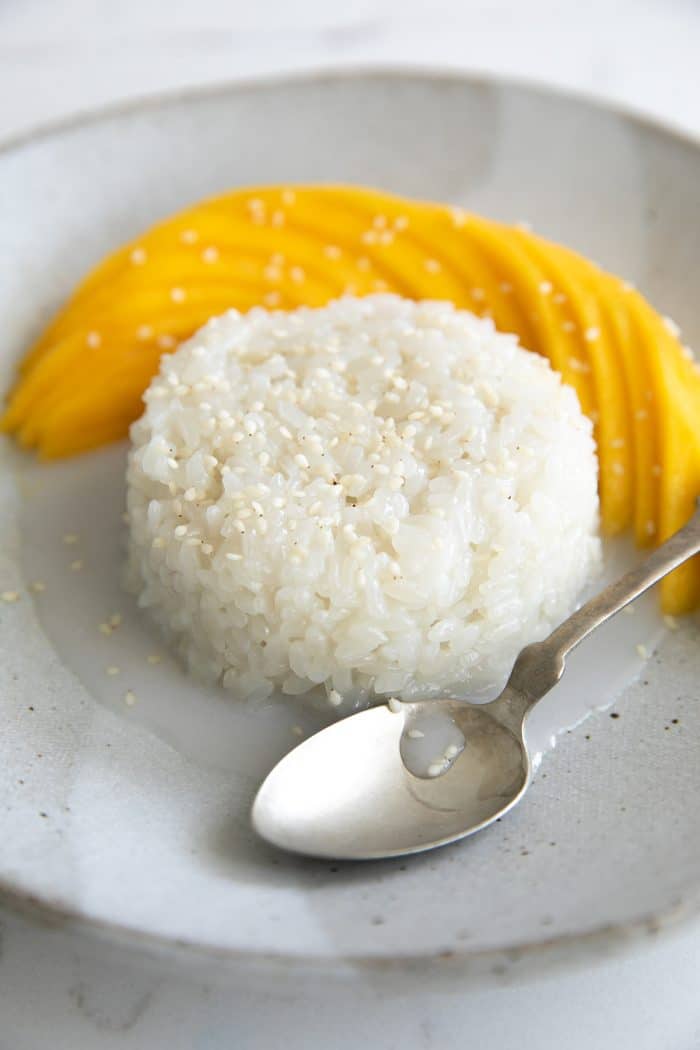
Thai Mango Sticky Rice Recipe
Ingredients
- 2 cups sweet rice
- 1 (13.5 ounce) can full-fat coconut milk
- 6 tablespoon sugar
- ½ teaspoon salt
- 1-2 large mangoes
- Sesame seeds, to garnish
For the coconut cream sauce
- ⅔ cup full-fat coconut milk
- 3 tablespoon sugar
Instructions
- Soak. Transfer the rice to a large bowl filled with water. Make sure the bowl is large enough to hold enough water to cover the rice. Allow the rice to soak for at least 1 hour or up to overnight.
- Wrap up the rice in a cheesecloth. After the rice has been soaking for at least one hour, drain and rinse, then transfer to the center of a large cheesecloth. Allow it to drain. Then loosely wrap the rice in the cheesecloth (loose, yet secure enough that none of the grains can escape).
- Prepare your steamer. I do not own a sticky rice steamer pot (which I expect is the same for many of you as well). I improvised and made my own by inverting a large mesh stainless steel steaming basket and placing it in a tall pot. The inverted basket creates a barrier between the boiling water at the bottom of the pot and the cheesecloth wrapped rice resting on top of the steamer basket. Since we're steaming the rice, the idea is to keep the rice from being submerged in water.
- Steam. Add enough water to your pot so that it is filled by approximately 1-inch. Transfer the wrapped-up rice to the pot and place it on top of the steaming basket (making sure it doesn't fall to the side and into the water). Cover with a tight-fitting lid and bring water to a boil over high heat. Reduce heat to a simmer and allow the rice to steam for 15-20 minutes, or until grains become translucent.
- Heat the coconut milk. As the rice steams, heat 1 can of coconut milk over medium heat. Stir often to prevent the coconut milk from burning or curdling. Add the sugar and salt, stirring continuously until dissolved. Set aside, keep warm.
- Put it together. Transfer the steamed rice to a large bowl and mix with the sweetened coconut milk. Cover. Allow rice to rest for 5 minutes as it absorbs the coconut milk.
- Prepare the coconut cream sauce. In a small saucepot, add the coconut cream (or milk) and sugar. Bring to a low boil, then reduce heat to low. Simmer until slightly thickened.
- Serve. Transfer a scoop or warm coconut sticky rice to a small serving plate and serve with seasonal mango, coconut cream sauce, and a small sprinkle of sesame seeds, if desired.
Notes
Nutrition
Nutrition information is automatically calculated, so should only be used as an approximation.
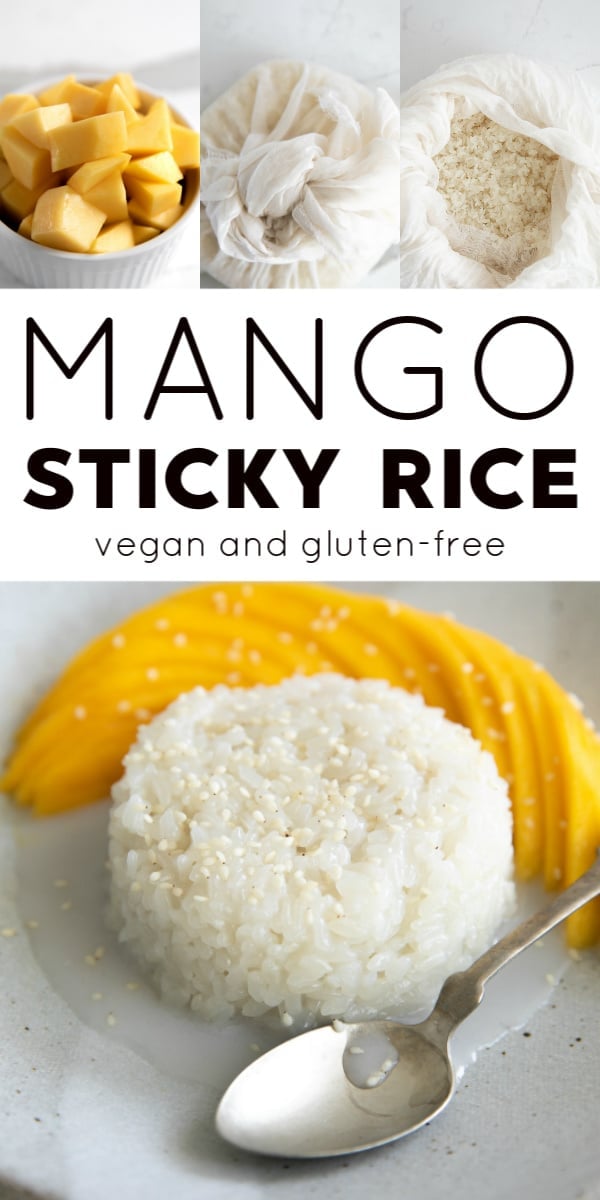
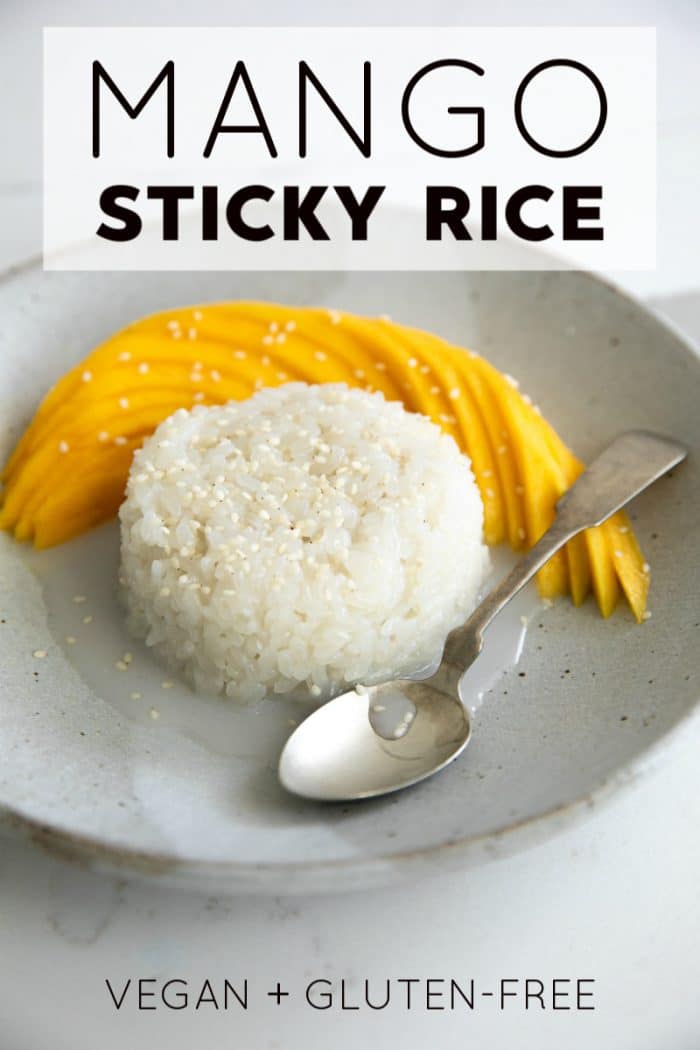
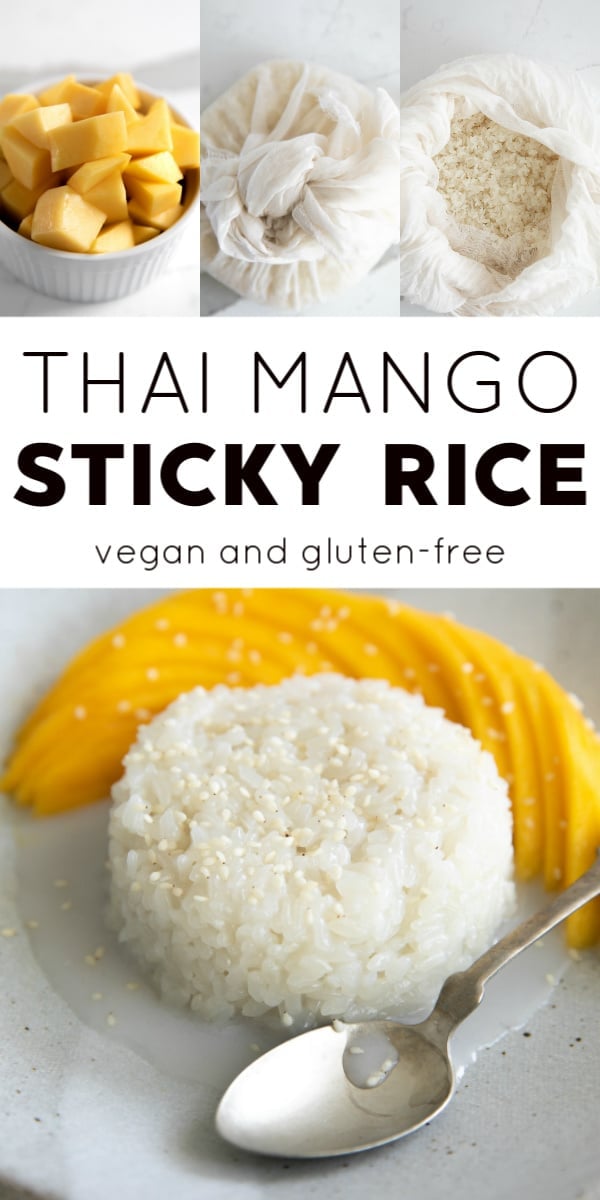
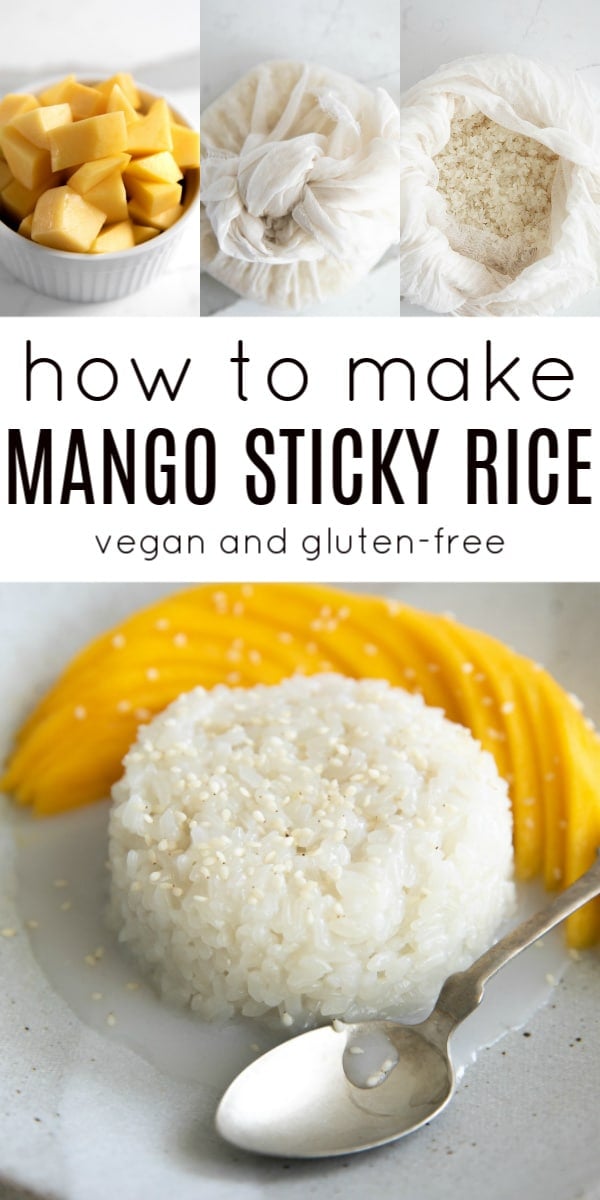

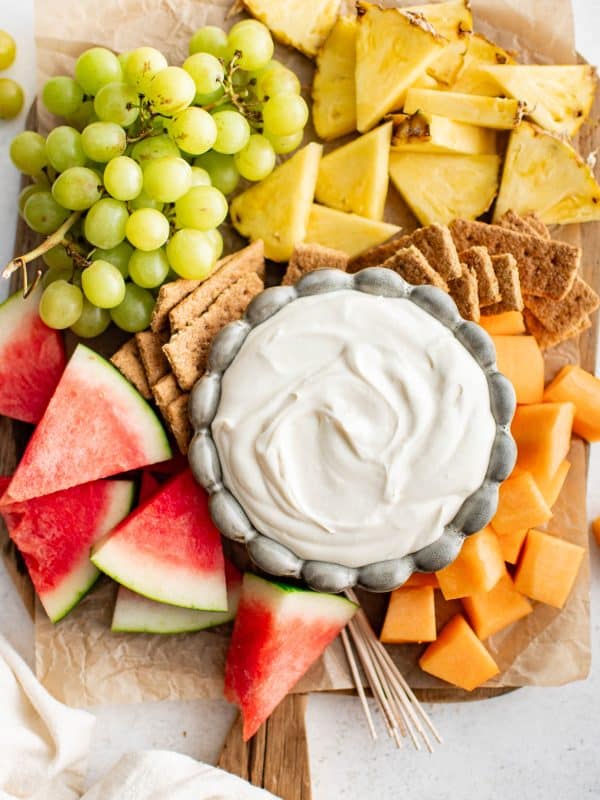
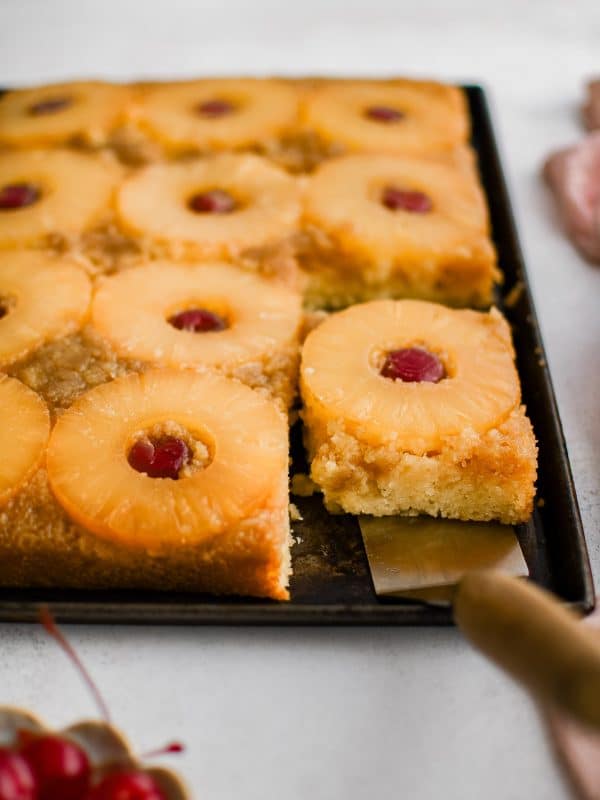
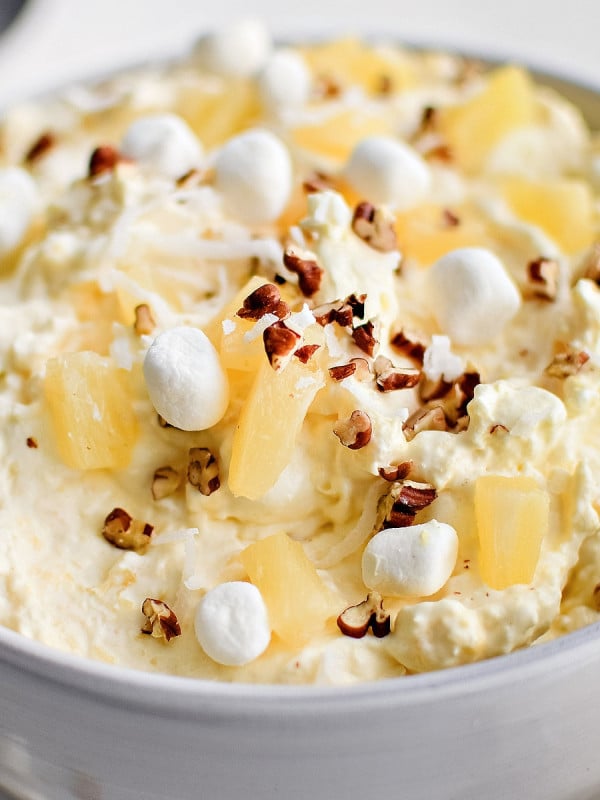









The flavor of our finished product was great! We only soaked the rice for 2.5 hours. User error- we could have cooked the rice longer to let it soften more. I personally will add a bit less sugar for myself next time, but my kids enjoyed the sweetness of the dessert. Overall, clear directions that were easy to follow and a very tasty dessert.
Thank you so much for your thoughtful feedback! I’m glad you enjoyed the flavors and found the directions easy to follow. And I love hearing that your kids enjoyed the sweetness. Thanks again for trying the recipe and sharing your experience!
can i make this in advance and heat it up for serving?
Yes, you can make mango sticky rice in advance and reheat it for serving. For best results, store the sticky rice and coconut sauce separately in airtight containers in the refrigerator. When ready to serve, gently reheat the rice in the microwave or steam it until warmed through, and warm the coconut sauce as well. Then assemble with fresh mango just before serving for the best texture and flavor.
See my section on storage and reheating in the post above as well 🙂
Love it! 😍 I made extra sauce to put in the fridge and put a pinch of salt and 1/2 tsp of vanilla bean paste in it. My boys are big fans for sure.
I’m so happy to hear that—thank you! 😍 I love the idea of adding vanilla bean paste and making extra sauce (smart move!). So glad your boys are fans too—it’s always a win when the whole family enjoys it!
Awesome and sooo easy. My rice cooker has a sweet rice option that worked perfect.
Thanks for the awesome feedback and rating, Sue 😀
We followed the recipe to a T. Absolutely loved it. Wouldn’t change a thing.
Cheesecloth and steamer basket is a must.
We know someone who used a rice cooker. Nooo good.
I have been trying to find an authentic mango sticky rice recipe where the rice is soaked and then steamed. This recipe is exactly like the mango sticky rice at my favorite Thai restaurant!
How is this gluten free as you post in your notes? Im so confused.
Gluten comes from the grains wheat, barley, and rye. Rice, while also a grain, is not any of those specific grains carrying the gluten protein. Rice does not have gluten, nor do any of the other ingredients, which makes this completely gluten-free 🙂